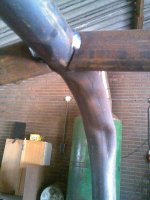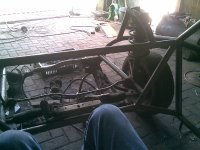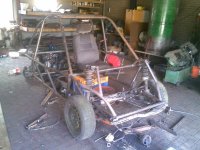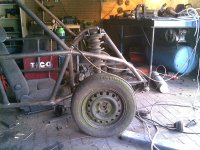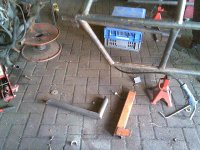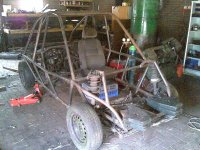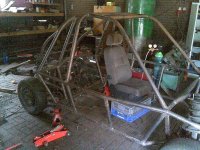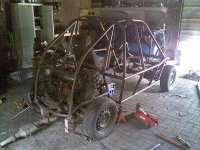You are using an out of date browser. It may not display this or other websites correctly.
You should upgrade or use an alternative browser.
You should upgrade or use an alternative browser.
building a dirt buggy
- Thread starter Renze
- Start date
- Views: 33017
More options
Who Replied?
/ building a dirt buggy
#11
Some more pics:
Photo 1 shows the pipe weld joints as i did in 90% of the joints:
I took off an edge at 45° with the angle grinder. After grinding it off, i had to touch it up with the bench grinder to get a good fit to the round pipe.
photo 2:
A photo from the drivers seat, you can see the Volvo subframe with a power steering rack and pinion housing, a powersteering pump on the ground, still connected with the hoses to prevent dirt from entering the system.
You can also see how the spring struts are connected to the frame. I need to put a connecting bridge inbetween them and solidify it by making angles.
The spring struts themself are bolted with 2 M8 bolts onto 2 angle irons.
I sawed a hole into the angle iron and then chopped off the angle iron in half with the band saw, so the result is 2 angle irons with a half radius.
photo 3 shows an overview picture of the buggy, front part on wheels, rear end on 2 bricks.
the original Volvo seat is placed on 3 plastic butcher's crates, at about the correct seat height.
When sitting in the seat, i dont know how it will feel, i gues topping 200 km/h with this thing will be a bit more scary than when i did it with the car this motor comes from....
Anyways, i dont need to go that fast, when the cops try to catch me in the bush, i will quickly disappear out of sight and then be unfindable because i know the local forest better than any copper..
Photo 1 shows the pipe weld joints as i did in 90% of the joints:
I took off an edge at 45° with the angle grinder. After grinding it off, i had to touch it up with the bench grinder to get a good fit to the round pipe.
photo 2:
A photo from the drivers seat, you can see the Volvo subframe with a power steering rack and pinion housing, a powersteering pump on the ground, still connected with the hoses to prevent dirt from entering the system.
You can also see how the spring struts are connected to the frame. I need to put a connecting bridge inbetween them and solidify it by making angles.
The spring struts themself are bolted with 2 M8 bolts onto 2 angle irons.
I sawed a hole into the angle iron and then chopped off the angle iron in half with the band saw, so the result is 2 angle irons with a half radius.
photo 3 shows an overview picture of the buggy, front part on wheels, rear end on 2 bricks.
the original Volvo seat is placed on 3 plastic butcher's crates, at about the correct seat height.
When sitting in the seat, i dont know how it will feel, i gues topping 200 km/h with this thing will be a bit more scary than when i did it with the car this motor comes from....
Anyways, i dont need to go that fast, when the cops try to catch me in the bush, i will quickly disappear out of sight and then be unfindable because i know the local forest better than any copper..
Attachments
dbdartman
Platinum Member
Only thing that scares me is the bends you made with the wrong size shoes (VERY noticeable in your last pics). The kinks in the bend WILL be your weak point & WILL fold. A large X in the main hoop would be my first suggestion, but gussets at a 45° angle with 1-1/4" tube under those bends would be better than nothing. I would hate to hear that you put it on it's side & the cage folded over on you!
Your ties from the front to the main cage look good! Should allow some movement, plus in a hard hit should fold without too much distortion of the main cage.
Your ties from the front to the main cage look good! Should allow some movement, plus in a hard hit should fold without too much distortion of the main cage.
tlbuser
Veteran Member
A great thread and neat pics. I do have a concern about your battery placement. How do you intend to contain the acid if the battery gets ruptured?
dbdartman, yes i took that photo to illustrate the fishmouthing of the pipes, AND the deformation of the pipe in the bend, however i didnt mention it in the description.
I could correct the leg-to-leg distance of the rollbar by simply putting one end under my workbench and putting my 70 kg of body weight on it... I know that aint good, but i will at least weld 2 X-es into the structure: 1 directly behind the passenger cage, and one in the rear structure (i havent built that yet) that will run from the rear subframe mounts to the upper part of the rollcage. then i can extend the rigidity further forward by adding some crossbars in the`roof`
The ovaled pipes arent ideal, but i dont worry that much about them, sometimes, something turns "right" by going left 3 times
About the ties from front to passenger cage, my guess is that in case of impact, the front Volvo subframe will be ripped of its four M12 bolts and will simply disappear underneath the buggy...
When thinking it over, i might have to have an arch in the pipes that run straight forward, so they will fold up instead of folding the front uprights of the passenger cage....
With some gussets i can put the weakest point a bit further away from the passenger cage, to achieve the crumble zone.
I'm not intending to crash it, but with my friends crash experience we just want to be prepared... My friend didnt drive fast or reckless, he simply fell asleep after a 12 hour night shift... You dont have to be reckless to get yourself in serious trouble, we both realise that very well now...
TLB user, my plan was to rivet some plastified sheet steel around the buggy, leftovers from the horse riding hall my brother built last year. It is featherlight and has a nice camouflage dark green colour.
The floor, and the front firewall i'll make of 18mm plywood. I have an original Volvo hood which with a little force, we can fold over the front part of the buggy.
I'll probably make a crate out of angle iron, which can accept some 60x40cm washed gravel patio stones as ballast.
It's thursday now, and today will be the last day that i'm working in my fathers sow barn, cutting up cages to turn them into hog raising sties.
My father turns 65 next year, but because the weeners are cheaper than the feed they eat, where meat hog prices are reasonable, he decided to stop a little earlier and raise the weeners in the old sow barn to get some money from those weeners.
With the foot and mouth disease in England, we can only move animals to the butcher, and not sell the 23-25kg weeners. (doing just 18 euro per weener) Because of this, i have to hurry up a little to make the hog raising barn ready, otherwise we run out of nursery stalls.
The point i was trying to make with the hogs and weener sideline talk, is that rebuilding the sow barn into a raising barn is a higher priority than the buggy, and that i hope to finish the stink work today and continue on the dirt buggy tomorrow...
I could correct the leg-to-leg distance of the rollbar by simply putting one end under my workbench and putting my 70 kg of body weight on it... I know that aint good, but i will at least weld 2 X-es into the structure: 1 directly behind the passenger cage, and one in the rear structure (i havent built that yet) that will run from the rear subframe mounts to the upper part of the rollcage. then i can extend the rigidity further forward by adding some crossbars in the`roof`
The ovaled pipes arent ideal, but i dont worry that much about them, sometimes, something turns "right" by going left 3 times
About the ties from front to passenger cage, my guess is that in case of impact, the front Volvo subframe will be ripped of its four M12 bolts and will simply disappear underneath the buggy...
When thinking it over, i might have to have an arch in the pipes that run straight forward, so they will fold up instead of folding the front uprights of the passenger cage....
With some gussets i can put the weakest point a bit further away from the passenger cage, to achieve the crumble zone.
I'm not intending to crash it, but with my friends crash experience we just want to be prepared... My friend didnt drive fast or reckless, he simply fell asleep after a 12 hour night shift... You dont have to be reckless to get yourself in serious trouble, we both realise that very well now...
TLB user, my plan was to rivet some plastified sheet steel around the buggy, leftovers from the horse riding hall my brother built last year. It is featherlight and has a nice camouflage dark green colour.
The floor, and the front firewall i'll make of 18mm plywood. I have an original Volvo hood which with a little force, we can fold over the front part of the buggy.
I'll probably make a crate out of angle iron, which can accept some 60x40cm washed gravel patio stones as ballast.
It's thursday now, and today will be the last day that i'm working in my fathers sow barn, cutting up cages to turn them into hog raising sties.
My father turns 65 next year, but because the weeners are cheaper than the feed they eat, where meat hog prices are reasonable, he decided to stop a little earlier and raise the weeners in the old sow barn to get some money from those weeners.
With the foot and mouth disease in England, we can only move animals to the butcher, and not sell the 23-25kg weeners. (doing just 18 euro per weener) Because of this, i have to hurry up a little to make the hog raising barn ready, otherwise we run out of nursery stalls.
The point i was trying to make with the hogs and weener sideline talk, is that rebuilding the sow barn into a raising barn is a higher priority than the buggy, and that i hope to finish the stink work today and continue on the dirt buggy tomorrow...
Last edited:
O.k. guys, i could make a little progress yesterday, but it definately shows where it is going:
Photo 1
A side close-up of how the front wheel strut is connected to the frame. These are the parts that consume the most time, as there are no straight lines to work from and the pipes have to be bent in all kinds of directions to get them where i want them.
Photo 2:
When i welded the rear subframe mounting brackets to the lower rear pipe, the wheelbase turned out to be 2.55 meter. The wheelbase of the donor car was 2.50 meter. This way the rear end would stick out, making it all a bit out of proportion.
I decided to chamfer off the rear end of the cage about 20 centimeter, bringing the wheelbase back to 2.35 meter (or 92 and 1/2 inch)
Photo 3:
photo 3 shows the rear subframe lifted onto bricks and jack stands, with the front brackets bolted up but no supports to the rear subframe mounts.
when everything is aligned i can fit the pipes inbetween the given dimensions.
Photo 1
A side close-up of how the front wheel strut is connected to the frame. These are the parts that consume the most time, as there are no straight lines to work from and the pipes have to be bent in all kinds of directions to get them where i want them.
Photo 2:
When i welded the rear subframe mounting brackets to the lower rear pipe, the wheelbase turned out to be 2.55 meter. The wheelbase of the donor car was 2.50 meter. This way the rear end would stick out, making it all a bit out of proportion.
I decided to chamfer off the rear end of the cage about 20 centimeter, bringing the wheelbase back to 2.35 meter (or 92 and 1/2 inch)
Photo 3:
photo 3 shows the rear subframe lifted onto bricks and jack stands, with the front brackets bolted up but no supports to the rear subframe mounts.
when everything is aligned i can fit the pipes inbetween the given dimensions.
Attachments
EddieWalker said:I don't know anything about the vehicles your using, so it will be fun to follow your progress and see how it all comes together.
Eddie, i posted some pics of the donor car in an earlier thread.
this is a picture of how the components were tested for buggy suitability before disassmbling the donor car:
http://www.tractorbynet.com/forums/...916586-one-couldnt-think-oneself-im000690.jpg
schmism
Super Member
performace over jumps have everything to do with
spring ratios
shocks.
to much front spring your launch nose high.
to much rear spring the back end launches up and you land hose heavy
shocks dont affect takeoff... just landing.
spring ratios
shocks.
to much front spring your launch nose high.
to much rear spring the back end launches up and you land hose heavy
shocks dont affect takeoff... just landing.
The car landed nose down every time. The weight distribution was somewhere between 51 and 53% front, i think. Now we've got the suspension in the buggy with half of its weight removed, it will be a bit stiff. because the engine is now in the rear, the weight ratio is totally different and i think i have to use front ballast to give the front end foothold to the ground, otherwise it will bounce around without any spring deflection.
When jumping a short bump as a ramp, shocks certainly have to do something with it.
When jumping a short bump as a ramp, shocks certainly have to do something with it.
Some more photos:
Friday night i worked in the workshop till 11, and i could spend a couple of hours on saturday.
Photo 1:
when i jumped on the front end, there was no spring deflection. all movement i got, was from a poorly inflated tire.
I put 4 Ford tractor front weights on the front, i guess its about a 150 kg. Then i could spring it about 2 inches when i used my body weight to jump on it.
I guess i need an oak strunk as front bumper annex ballast.
photo 2:
A photo of the rear part of the frame, where the engine fits.
Photo 3:
rear view: With this shape and height, with sufficient fantasy it resembles a Volvo XC 90 SUV...
This is the most tricky part, because it needs to hold not just the spring struts but also clear 2 driveshafts, and hold 2 rubber motor mounts: The engine should also hang in the middle because the homokinetic joints of the driveshaft are going to jerk if it doesnt...
Just one advantage of the rear wheel drive set-up: Even with extreme spring travel, the angles of the homokinetic joints are reduced because the wheels dont have to make a steering angle anymore.
Friday night i worked in the workshop till 11, and i could spend a couple of hours on saturday.
Photo 1:
when i jumped on the front end, there was no spring deflection. all movement i got, was from a poorly inflated tire.
I put 4 Ford tractor front weights on the front, i guess its about a 150 kg. Then i could spring it about 2 inches when i used my body weight to jump on it.
I guess i need an oak strunk as front bumper annex ballast.
photo 2:
A photo of the rear part of the frame, where the engine fits.
Photo 3:
rear view: With this shape and height, with sufficient fantasy it resembles a Volvo XC 90 SUV...
This is the most tricky part, because it needs to hold not just the spring struts but also clear 2 driveshafts, and hold 2 rubber motor mounts: The engine should also hang in the middle because the homokinetic joints of the driveshaft are going to jerk if it doesnt...
Just one advantage of the rear wheel drive set-up: Even with extreme spring travel, the angles of the homokinetic joints are reduced because the wheels dont have to make a steering angle anymore.
